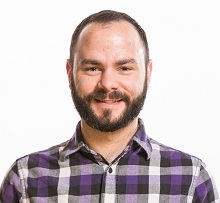

Wednesday December 5 2018 began quietly – academics are creatures of comfort, and when the December sky is dark and wet, the Living Systems Institute at the University of Exeter is slow to wake – but by noon the building would be buzzing with talk of spiral waves and cardiac arrhythmias as attendees arrived for the appropriately named ”Spiral waves and cardiac arrhythmias – connecting the clinic and mathematics“ workshop. This was the culmination of months of organisational effort, bringing together international expertise on cardiac arrhythmias from mathematical, experimental, and clinical perspectives. Our goal from the outset was to provide a casual environment for people in the field to be exposed to differing perspectives and share their enthusiasm for this topic outside of the formal confines of scholarly publications and seminars. The start of the workshop is far from the beginning of the workshop, however, so before we discuss the details of 5-7 December 2018, we should hop back to May 2018.
Cardiac arrhythmias include anything which is not the normal rhythm – the one-to-one coherent contraction of the atria and ventricles of the heart. Cardiovascular diseases, which include cardiac arrhythmias as well as afflictions such as strokes, are responsible for 17.9 million or 31% of deaths worldwide, annually. [1] In the UK, every three minutes someone goes to the hospital due to a heart attack. [2] Despite their prevalence, in my experiences interacting with the public about my work on cardiac arrhythmias, very few people are at all familiar with the mechanical functioning of the heart, much less how that mechanical functioning breaks down during a heart attack.
The contraction of the heart muscle is controlled by electrical waves sent to the tissue. During normal rhythm, these waves are received with a steady pacing and the chambers of the heart each contract in a coordinated fashion, which efficiently pumps the blood out of the chamber, and over the course of a complete heart beat moves blood throughout the body. The development of a heart attack is thought to progress from the normal rhythm due to an interruption of pacing of this electrical signal. If this pacing is interrupted, the next wave may arrive early or late, and interact with previous waves, further disrupting the steady pacing of the normal rhythm. This sustained interruption of the normal pacing would correspond to an abnormal atrial rhythm, and can progress into waves which break locally and interact with anatomical features of the muscle like scars. When these electrical waves rotate (whether around an anatomical feature of the tissue or otherwise), this corresponds to atrial tachycardia (increased heart rate when resting). The rotation of these waves is typically much faster than the normal rhythm (“tachy“ means ‘faster’), which is not sustainable by the tissue, and so in short order atrial tachycardia will either die out and return the heart to the normal rhythm, or it will progress to atrial fibrillation. Fibrillation is the rapid uncoordinated contraction of the muscle, which is dangerous but not necessarily fatal in the atria. Fibrillation in the ventricles decreases the effectiveness of moving oxygenated blood through the body, and is typically fatal. Understanding the processes underlying the development of heart attacks and using mathematics to inform the clinical treatment of these disorders is the fundamental scientific thrust of the workshop.
By May, we knew we wanted to host a workshop, but none of the speakers had been invited, no space had been booked, the schedule and budget had not been considered – at this time we only had a topic and our ambition. Our first step was to make a short list of speakers to invite, while making clear our expectations for the topic and the tone of the workshop.
In considering speakers, it is essential to consider one’s own position in the field. My experience with cardiac arrhythmias is predominantly from a mathematical background. My work has looked at the properties of spiral waves as abstract patterns in idealised circumstances, and understanding atrial fibrillation as a regime in which several spiral waves interact. This perspective is limited in some respects. Clinicians do not see idealised spiral waves in real hearts, but rather electrical excitations which form re-entrant circuits – paths of excitation which reconnect at a later time – in the tissue. The gulf between my experiences and those of clinicians meant that I needed to reach outside my zone of expertise when thinking of inviting speakers. Thankfully, our research group surrounds us with people of diverse research backgrounds which gave us the tools to identify and connect to those with clinical experience. Dr. Yolanda Hill has essential experiences distinct from my own, and put us in touch with clinicians and perspectives beyond the purely mathematical.
Getting clinicians and mathematicians in the same room, putting faces to names, and telling research stories with one’s own voice, is absolutely invaluable. Giving people the opportunity to ask questions and interrogate results without the constraints of page limits and overloaded inboxes brings a research community together. In the short term we have fostered new opportunities for collaboration, and in the long term we have laid the foundation for better understanding and treatment for cardiac arrhythmias.
Once we had secured the speakers, secured a venue to host the workshop and the public lecture, and made sure everyone was fed and present thanks to the heroic efforts of our administrative team, we had the workshop to run. Preparation and performance are dual requirements for a successful workshop or indeed any event, and Yolanda and I were able to manage the different demands of the workshop by relying on each other. Running the workshop was exhausting, but also incredibly rewarding.
We had eight plenary seminars, two contributed seminars, a public lecture scheduled for the evening, posters, and dedicated sessions for the discussion of research problems by the audience to get feedback on from the rest of the attendees – all fit within two days, total. While this reads as a packed schedule, we managed to find a leisurely pace by spreading the workshop across two half-days and one full day. Several attendees remarked that the pace of the schedule was very helpful to make the experience less stressful and to foster interesting conversations, since there was little time pressure. From the outset, we wanted to ensure that discussion was prioritised and the pace of the schedule was one way in which we were able to accomplish this. The schedule pacing also let us distinguish this workshop from a typical conference, in which most of the attendees present, and as a result discussion is truncated or done outside the meeting.
The workshop was, overall, a huge success. The seminars were interesting and sparked lively discussions. It was an opportunity to introduce researchers from across the US and UK to each other, and attendees who were new to the field of cardiac research were properly welcomed and given the opportunity to interact with some of the leaders in this field of research. This workshop is influencing my own research interests in unexpected ways, as well. One of the themes of the seminars was the remodelling of the dynamics of cells when they are pushed much faster than the normal rhythm, as in the case of tachycardia and especially fibrillation, and how this remodelling might manifest in real hearts. Most models of cardiac cells are developed when the cells are driven near or only slightly faster than the normal rhythm, and so we might expect that this cell remodelling is not present in existing models. Development of simple cardiac cell models which capture this remodelling may further develop our understanding of sustained cardiac arrhythmias and bring accurate patient-specific predictive modelling to better inform and guide medical doctors when faced with long-lived arrhythmias.
[1] https://www.who.int/cardiovascular_diseases/world-heart-day/en/
[2] https://www.bhf.org.uk/-/media/files/research/heart-statistics/bhf-cvd-statistics—uk-factsheet.pdf?la=en